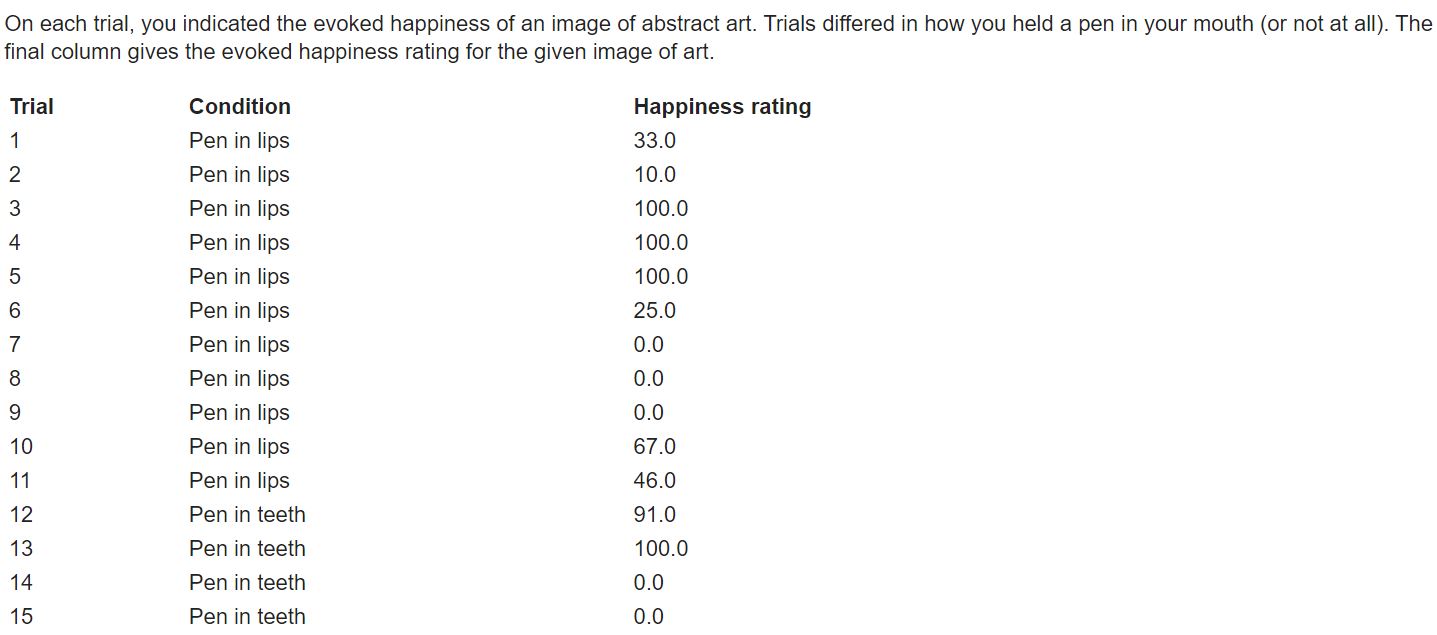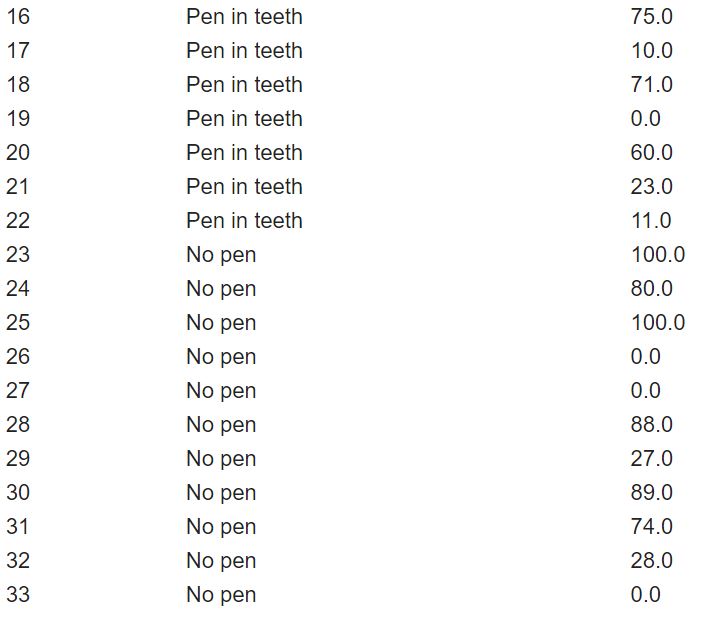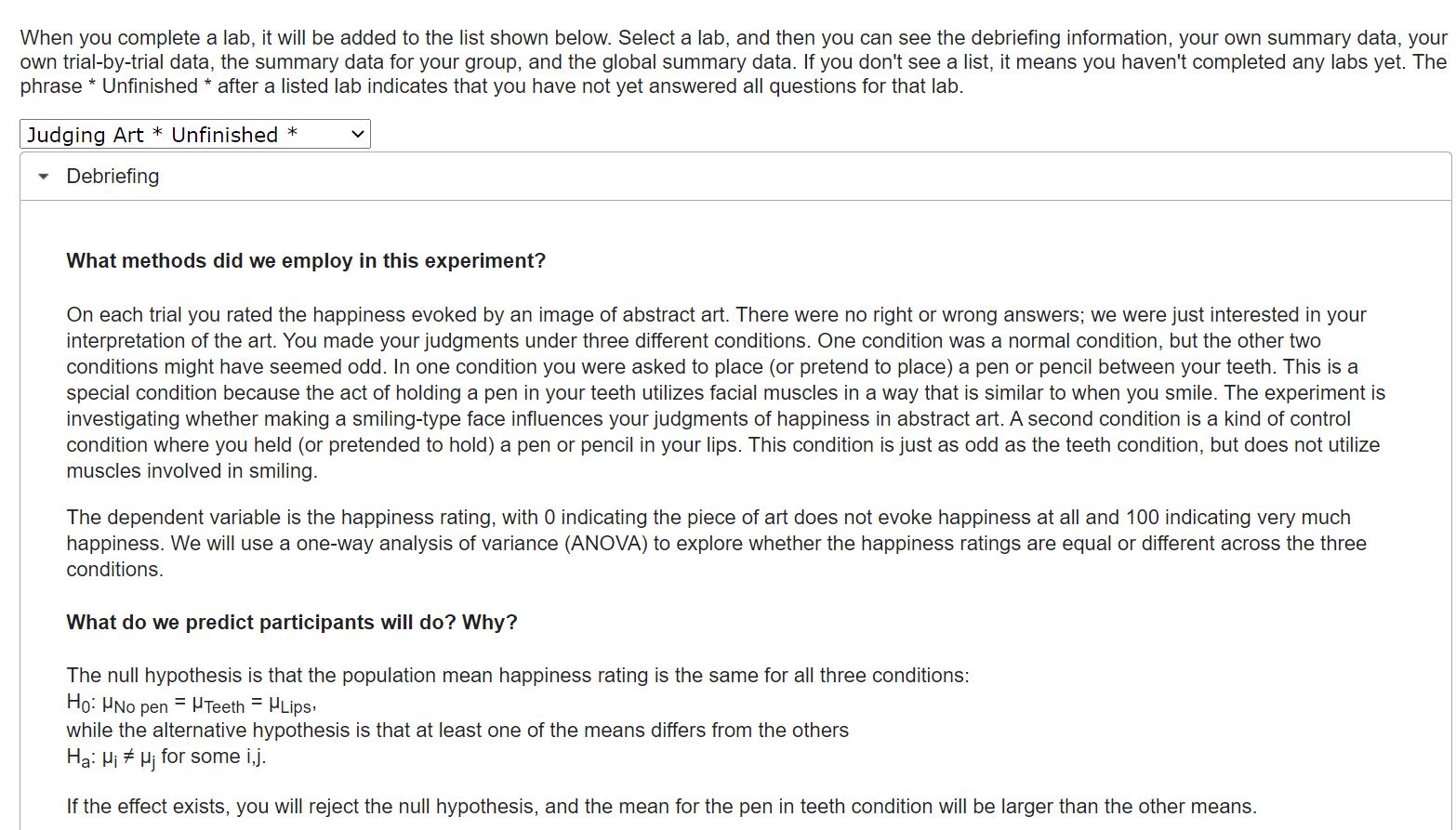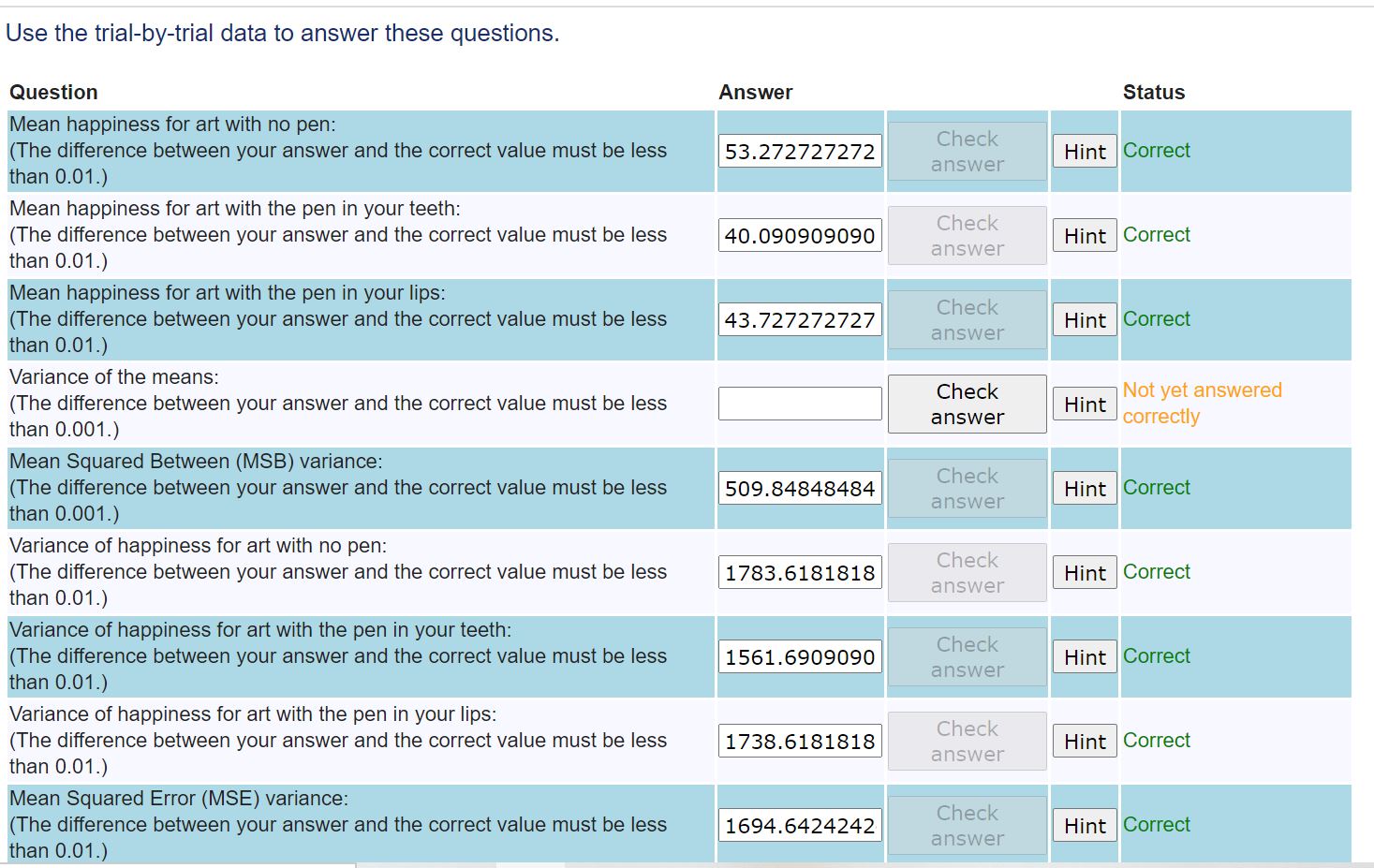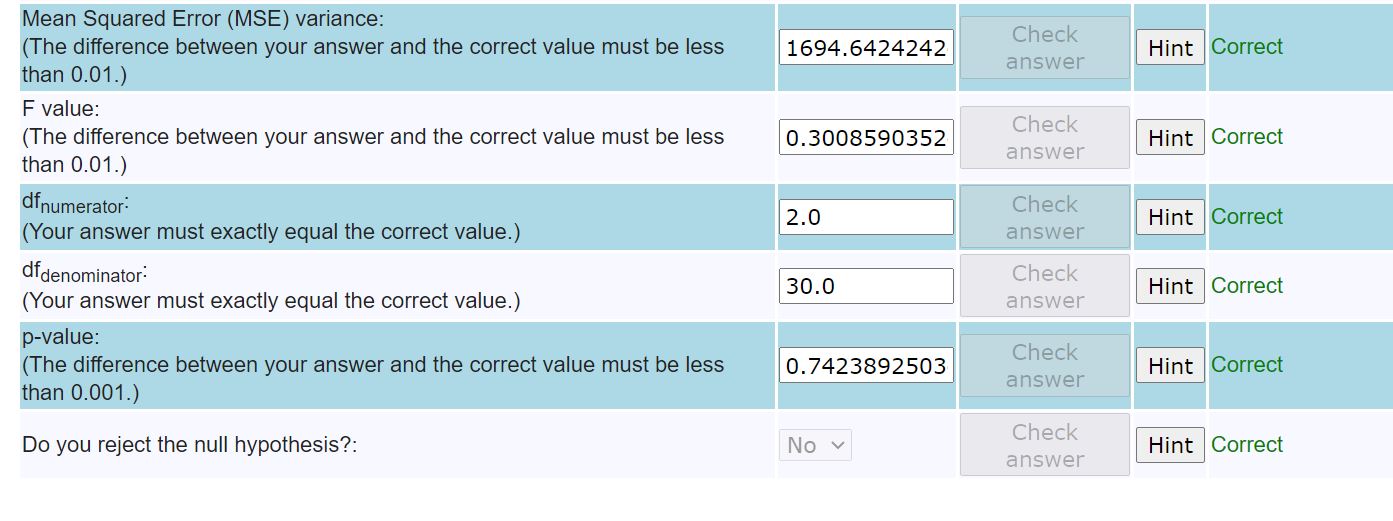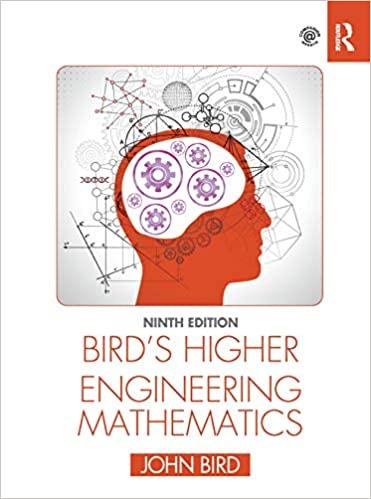Hello!!
Using the data ( 33 trials) and debrief (instructions) documents attached, please answer the questions ( I am missing question 4). I am not as good as you all are in statistics and can't figure it out :( Please help and thank you so much.
On each trial, you indicated the evoked happiness of an image of abstract art. Trials differed in how you held a pen in your mouth (or not at all). The final column gives the evoked happiness rating for the given image of art. Trial Condition Happiness rating 1 Pen in lips 33.0 2 Pen in lips 10.0 3 Pen in lips 100.0 4 Pen in lips 100.0 5 Pen in lips 100.0 6 Pen in lips 25.0 ? Pen in lips 0.0 8 Pen in lips 0.0 9 Pen in lips 0.0 10 Pen in lips 67.0 11 Pen in lips 46.0 12 Pen in teeth 91.0 13 Pen in teeth 100.0 14 Pen in teeth 0.0 15 Pen in teeth 0.0 16 17 18 19 20 21 22 23 24 25 26 2? 28 29 30 31 32 33 Pen in teeth Pen in teeth Pen in teeth Pen in teeth Pen in teeth Pen in teeth Pen in teeth N0 pen No pen No pen No pen N0 pen No pen N0 pen No pen No pen No pen N0 pen 75.0 10.0 Y1.0 0.0 60.0 23.0 11.0 100.0 80.0 100.0 0.0 0.0 88.0 27.0 89.0 ?'4.0 28.0 0.0 When you complete a lab. it will be added to the list shown below. Select a lab, and then you can see the debrieng information, your own summary data, your own trial-bytrial data, the summary data for your group, and the global summary data. If you don't see a list, it means you haven't completed any labs yet. The phrase * Unfinished * after a listed lab indicates that you have not yet answered all questions for that lab. Judging Art * Unnished * v v Debrieng What methods did we employ in this experiment? On each trial you rated the happiness evoked by an image of abstract art. There were no right or wrong answers; we were just interested in your interpretation of the art. You made yourjudgments under three different conditions. One condition was a normal condition, but the other two conditions might have seemed odd. In one condition you were asked to place (or pretend to place) a pen or pencil between your teeth. This is a special condition because the act of holding a pen in your teeth utilizes facial muscles in a way that is similar to when you smile. The experiment is investigating whether making a smiling-type face inuences yourjudgments of happiness in abstract art. Asecond condition is a kind of control condition where you held (or pretended to hold) a pen or pencil in your lips. This condition is just as odd as the teeth condition, but does not utilize muscles involved in smiling. The dependent variable is the happiness rating, with 0 indicating the piece of art does not evoke happiness at all and 100 indicating very much happiness. We will use a one-way analysis of variance (ANOVA) to explore whether the happiness ratings are equal or differth across the three conditions. What do we predict participants will do? Why? The null hypothesis is that the population mean happiness rating is the same for all three conditions: H0: \"No pen = \"Teeth = \"Lips: while the alternative hypothesis is that at least one of the means differs from the others Ha: pi # H] for some i,j. If the effect exists, you will reject the null hypothesis, and the mean for the pen in teeth condition will be larger than the other means. Formulas There are several ways to calculate the terms for an ANOVA. We will use formulas that make explicit the important parts of the approach. These formulas only apply to the case (as here) where there are equal sample sizes, n, for all groups. To calculate the ANOVA, you need to rst calculate the mean and variance of scores for each condition. This is done in the rst six questions. Now you compute two estimates of the population variance (ANOVA assumes that each condition has the same variance). The rst estimate is called Mean Square Between (MSB) because it derived from the variance between groups. To compute it we rst calculate the variance of the means. For three groups the raw score formula is: *2 i 2 2:-1 Xk (BL X.) /3 32B : f. This variance is then used to estimate the variance of the population with the following formula: 7 2 M SB \"33. where n is the number of scores in each group. The next step is to compute a second estimate of the population variance, which is called Mean Square Error (MSE). (Sometimes this estimate is called Mean Square Within, because it is based on the variances within each condition.) This is done by pooling the variances within each group: MSE: E The two estimates of population variance are then compared by computing the F ratio: MSB MSE ' which has two degrees of freedom. The rst is for MSB, dfnume,am,=K-1, where K is the number of groups. The second is for MSE, dfdenommam, = N-Kwhere N is the total number of scores across all groups. F: Finally, you can calculate the pvalue for the F ratio. This is most easily done with an online calculator. Answer the questions using the data below. You will often nd it helpful to sort the data and calculate values using a spreadsheet such as Microsoft Exce|, Sheets :.__.__ n___.|_ _._.__ n.__._ nu:__ __n_..__|____ a.-. _._I..| 1-_:._____nn__ 4.1. :._L_ _ ______|_|___; __|__; _.__| ___.. _nu._ __n_ :_ u__ ._:_1 L.. _:_| _|_;_ 1-\". L_l_... __4 u.-- Use the trialbytrial data to answer these questions. Question Answer Status Mean happiness for art with the pen in your teet:h Correct (The difference between your answer and the correct value must be less _0 090909090 than 0. 01. ) Not yet answered correctly Variance of the means: (The dierence between your answer and the correct value must be less than 0.001.) Hint 509 84848484 Variance of happiness for art with no pen: (The dierence between your answer and the correct value must be less 1783_ 6181818 than 0.01.) IIHI 1 Variance of happiness for art with the pen in your lips: (The dierence between your answer and the correct value must be less than 0.01 .) F value. (The dilference between your answer and the correct value must be less _ 3008590352 Hint Correct than 0. 01. ) df - denominator- ' :Hint__ COWBCt (Your answer must exactly equal the correct value. ) Do you reject the null .hypothesis?: ' No V| __ Hint Correct
